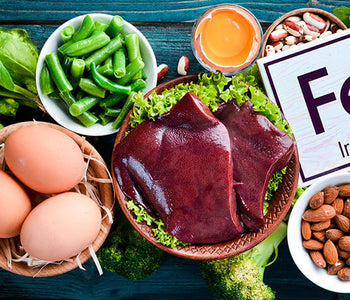Dan Brill - February 15, 20210
What is iron and why is it important?

Iron is a mineral that has many functions. Iron helps red blood cells carry oxygen through the body and supports a child’s ability to learn. Having enough iron in the body can help prevent iron deficiency and iron deficiency anemia.
What Happens If My Child Does Not Get Enough Iron?
If your child does not get enough iron, your child may develop anemia. Anemia is when there are not enough red blood cells in the body or your child’s ability to carry oxygen throughout the body is lowered. There are many causes of anemia. In young children, one common cause is not enough iron. Children who do not receive enough iron either from iron-rich foods or supplements are at greater risk for developing anemia.
When Does My Child Need Iron? And How Much?
All children need iron. It is important at all stages of your child’s development. Babies fed only breast milk, only formula, or a mix of breast milk and formula have different needs when it comes to iron.
Talk to your child’s doctor or nurse about your child’s iron needs at his or her next check-up.
Breast Milk
Breast milk can provide iron.
When your child is approximately 4 months old, he or she needs an additional source of iron.
Give your child standard over-the-counter iron drops. They contain enough iron at 1mg/kg per day.
Continue giving your child iron drops until he or she is regularly eating foods that contain iron.
Breast Milk
Your child’s iron needs can be met by standard infant formulas for the first 12 months of life.
Choose a formula that is fortified with iron. Most commercial infant formulas sold in the U.S. contain iron.
Standard iron-fortified infant formulas contain enough iron (12mg/dL) to support your growing child’s needs.
Once your child starts to eat foods, introduce your child to foods that contain iron.
Mix of Breast Milk and Formula
Your child’s iron needs will depend on how much breast milk and formula he or she consumes.
Talk with your child’s doctor or nurse about iron at your child’s next check-up.
Once My Child Starts to Eat Solid Foods, How Can I Make Sure My Child Gets Enough Iron?
Heme iron is most commonly found in animal products like red meat, seafood, and poultry. This type of iron is most easily absorbed by the body. Sources of heme iron include:
Red meat (for example, beef, pork, lamb, goat, or venison)
Fatty fish
Poultry (for example, chicken or turkey)
Eggs
Non-heme iron can be found in plants and iron-fortified products. This type of iron is less easily absorbed by the body and will require careful planning to get enough iron for your baby. Sources of non-heme iron include:
Iron-fortified infant cereals
Tofu
Beans and lentils
Dark green leafy vegetables
Pairing non-heme iron sources with foods high in vitamin C can help your baby absorb the iron he or she needs to support development. Vitamin C-rich fruits and vegetables include:
Citrus fruits like oranges
Berries
Papaya
Tomatoes
Sweet potatoes
Broccoli
Cabbage
Dark green leafy vegetables
Making sure your child is getting enough iron is important. Some children may need more iron than others. Talk to your child’s doctor or nurse about iron at your child’s next check-up.
Content source: Division of Nutrition, Physical Activity, and Obesity, National Center for Chronic Disease Prevention and Health Promotion
Order Mighty Kids for your family!

Products are sold as two cartons sets. And you can customize your orders by choosing from any of our six great tasting flavors.
ORDER NOW

